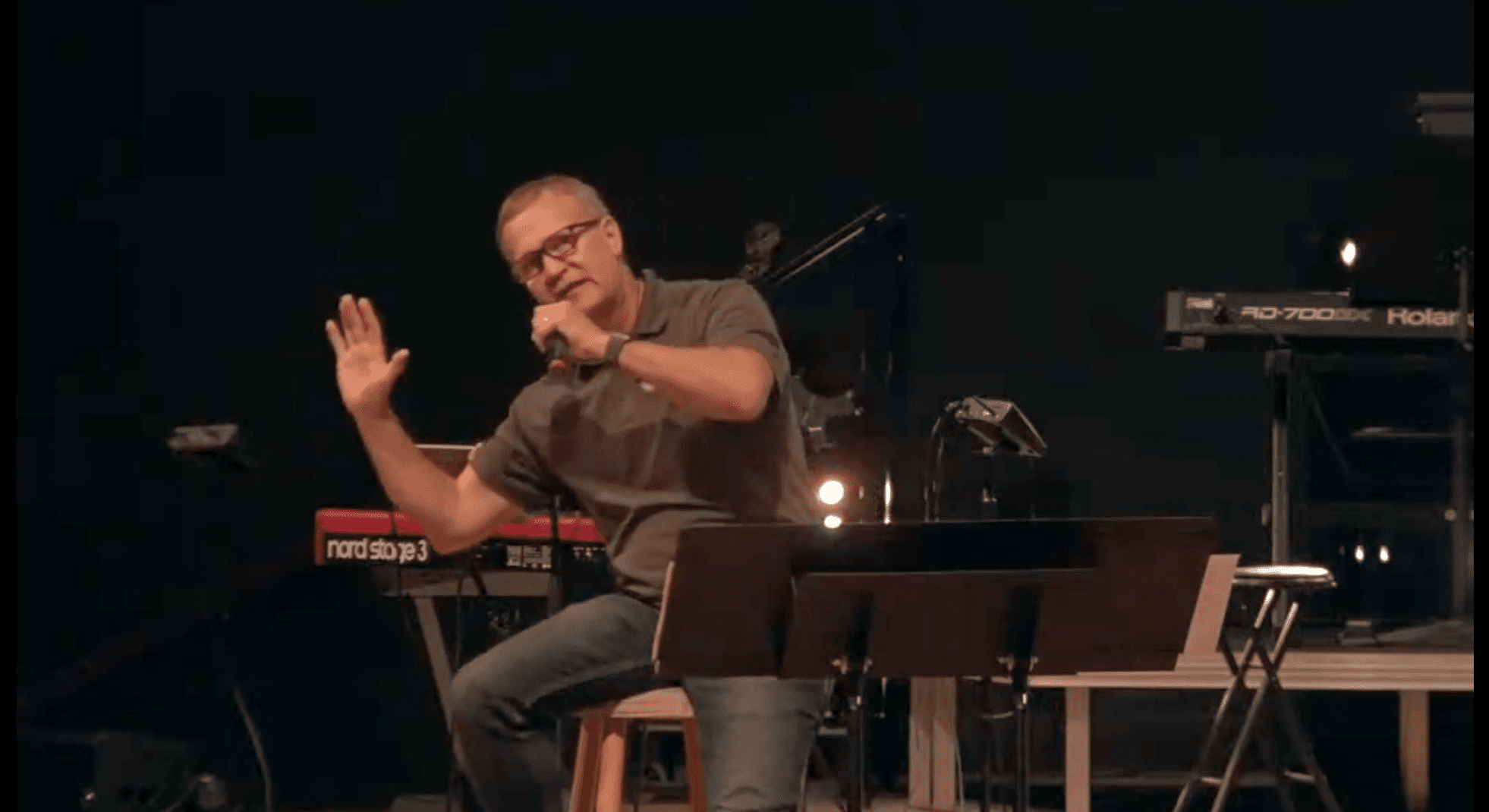Using Visual Arts in Worship
The following article is scheduled to run on Rick Warren’s Ministry Toolbox soon. I thought I would give you, my faithful readers, a “sneak preview”! Blessings! – Dwayne 
Have you gazed at the sky lately? Have you noticed the amazing colors and dazzling hues of an evening sunset? Have you ever been mesmerized by a gigantic rainbow with its backdrop of smoldering gray rain clouds? What variety our God gives us! What incredible creativity those heavens demonstrate! It’s as though every day presents a brand new canvas, and our awesome Creator graciously paints for us a new and original design from His endless palate of purples, reds and blues.
Mandate
If one has ever questioned the authenticity of visual art as a part of worship, all he or she needs to do is consider the priority our Lord placed on the ascetically beautiful when He made this world. His creation is nothing less than awe-inspiring.
Clearly, God’s creative handiwork is intentional. God purposefully made what we see around and above us to be more than just functional. He designed all of nature so that it would point us back to Him. No doubt that is what the shepherd boy, David, realized as he lay on a hillside night after night staring up at the stars. David recognized the profound purpose of those twinkling lights shining down on him. What he saw inspired him to worship. That is why he opened the 19th Psalm with these words: “The heavens declare the glory of God.”
God’s priority on the visual is not just evident in His creation. Certain worship encounters in God’s Word also had stunning visual effects. For example, consider what Isaiah saw in that service that led to his calling and commissioning in Isaiah 6. First, Isaiah saw the Lord. Had he not been given the opportunity in that vision to see the Lord, he would not have known that the Lord was high and lifted up or that the train of His robe filled the temple. Had he not seen the seraphim, Isaiah would not have known what those majestic creatures looked like or even what they did. Furthermore, Isaiah would not have realized the significance of the coal that touched his lips because he would not have seen one of the seraphim take the coal from the altar. The Lord not only allowed Isaiah to hear this life-changing service. The Lord knew Isaiah needed to see the visual elements in the service in order to fully experience that worship time and be moved by it.
Think, now, about the service in Revelation 4 and 5. Think through John’s description of that great, yet-to-be, worship gathering in heaven. The aspects of that service which were most significant and impacting were not those which John heard, but rather those that John saw. John saw the occupied throne in heaven. He saw the elders and the living creatures. Most importantly, John saw the Lamb of God, looking as if He had been slain. John was drawn into that unfathomable moment, and he was brought to his knees in worship, because of what he was privileged to see. This is the powerful effect “visual art,” if you will, can have on our senses and on our souls.
Motivation
While the Bible and nature both seem to strongly advocate visual arts which glorify God, perhaps our greatest reason to utilize visual and multi-sensory arts in corporate worship are people. Reaching those earthly creatures Jesus died for should motivate us to use whatever means we can to encourage them toward true, Biblical worship.
We know that people without Christ can be drawn to Him through seeing His attributes in nature. In fact, Romans 1:20 says they are “without excuse.” Those of us who know Christ may still at times need multi-sensory help as well, even among Jesus’ own disciples. Thomas, when he was told Jesus had arisen from the dead, said, “Unless I see in His hands the print of the nails, and put my finger into the print…I will not believe.” (John 20:25 NKV) Rather than ignoring Thomas’ need, Jesus invited Thomas to place his finger in His wounds and look at His hands. Truly, God has gone to much effort to visually show people how much He loves them and seeks after them. We, His representatives, should do no less…
Ted Smith was Billy Graham’s pianist for many years. In regard to the priority on the people we are trying to reach, he said, “For 47 years our stage at our crusades had the same things: blue bunting, flowers, a piano and an organ. We realized one day we had to change the look and design of our stage to appeal to younger generations.”
Our “younger generations” are a part of a new culture called “postmodernism.” These students and young adults have grown up with video games, text messaging and MTV. They take in and process information differently and often respond especially well to visual images and illustrations. Leonard Sweet uses the acronym EPIC to describe postmodern worship: Experiential, Participatory, Image-driven, and Connected.1
My friend, Michael Adler, is the Worship and Arts Pastor at Shades Mountain Baptist Church in Birmingham, Alabama. Recently he shared with me his convictions about becoming more relevant to our culture: “We have a stewardship to all the senses for about 90 minutes on Sunday mornings,” Michael said. “Everyone learns in a different way. I am constantly asking myself, ‘What do we need to do to wake up the guy in the third row?’”
Means
The Apostle Paul was desperate to reach others for Christ. And he was willing to step out of his comfort zones and meet them where they were. He wrote, “To the weak I became weak, to win the weak. I have become all things to all men so that by all possible means I might save some.” (I Corinthians 9:22 NIV)
In regard to visual arts in worship, what are some of the “means,” as Paul put it, through which we “might save some”?
Visual arts by the strictest definition includes two-dimensional art, such as painting, photography, and computer art, and three-dimensional art, including sculpture, installation art, or an architectural space. A third kind of visual art is kinetic art, such as cinematography or video art.2 However, for the purposes of this article we are also including performance arts like drama and dance as well as other primarily visual elements that are designed to enhance the corporate worship experience.
Some of the creative approaches that churches are pioneering now are rather astounding. For years, churches have used living Christmas trees and Easter dramas to relate and drive home the hope of Christ during certain holidays. However, in recent days, other kinds of visual effects are being used to make an impact, not just in special events, but during “regular” week-to-week services.
For example, Bell Shoals Baptist Church in Brandon, FL has theme-driven services. As their worship pastor, Simeon Nix, explained to me, they often illustrate each of the pastor’s sermon points with supporting “B-roll” video footage. Rather than simply showing the static text of his points on the screens, this background video runs for a minute or so as the pastor comes to each point. Michael Adler of Shades Mountain Baptist said they use ballet dancers at times to illustrate the beauty and message of a song. On other occasions, they use “prop art,” as he called it. Simple props are sat on the stage or held by mimes to enhance certain songs. Sometimes props that illustrate that day’s theme will change throughout the entire service.
The idea list for using visual art in worship is practically limitless. And the importance of such art cannot be overstated. More and more churches are prioritizing visual and multi-sensory art in their gathering times. In fact, some of the larger churches, like James River Assembly in Springfield, Missouri, have entire departments devoted to the creative arts!
Of course, if you work in a small church like I do, then your budget probably won’t allow you to have your own creative arts staff members. I am the worship leader at a new church plant in Hoover, Alabama called The Church at Ross Station. We have about 100 members at this time. Because of limited resources and our borrowed meeting space (a school gymnasium) we don’t try to bring visual art into every service. We try to provide unusual and creative elements about once a month, rather than weekly. Once every four to five weeks is enough to keep our services fresh and varied. We meet monthly with a creative arts team made up of our pastor and me, members of our praise team and a couple other volunteers. Our pastor, Randy Norris, gives us his general message themes at least two to three months in advance. This allows us to brainstorm on great ideas and have time to prepare the best presentations possible.
Our church often downloads videos and other visual resources from the web. For churches that don’t have their own video production and creative arts staff, these sites are an incredible asset. They include http://www.sermonspice.com/, http://www.bluefishtv.com/, and www.Willowcreek.com/willowdrama.
Message
It needs to be clearly stated that visual arts should never take the place of the spoken word in our worship gatherings. Paul’s words in Romans 10:14 still ring true: “…how can they believe in the one of whom they have not heard? And how can they hear without someone preaching to them?” (NIV) Visual arts certainly can present a message in text on the screen or on poster board. Nonetheless, most often such art is best utilized to support and enhance the message. Visual effects inspire and intrigue people and help open their hearts so they will listen to what God wants to speak to them. Multi-sensory elements can even help “close the deal” and bring people to greater faith in Christ, as we saw with the “doubting” disciple, Thomas.
Most importantly, any creativity within our worship services must be Spirit-initiated and Spirit-led. Only God knows exactly who will be in those services, and only He knows what they need to see in order to reach them. After all, He is the Creator through us. And when He creates visual art through us, art that He can use for His glory – whether it’s a beautiful painting or a poignant video – such art will never be a bad thing that we, His church, should avoid. Rather, it is a holy thing we should embrace…
1 Sheer, Greg, 212, The Art of Worship, 2006, Baker Books
2 Crowley Eileen D., What is Liturgical Media Art? Calvin Symposium on Worship and the Arts, January 29-31, 2004
(c) 2007 by Dwayne Moore
3 Comments
-
neal parrow
I never heard of Dwayne Moore before, but what a sharp and amazing article he penned with this. Thank you Dwayne, for your insight and well researched and thought out article!!
Leave a Reply
You must be logged in to post a comment.




Jane Fetsch
Thank you for the encouraging article. Please check out our ministry. We are an outreach program & ministry in the form of art exhibits and art classes.
Thank you for your interest.
Sincerely in Christ,
Jane Fetsch,
N.R.Productions, LTD.
Narrowroad Ministries
c/o The YOUNG ARTISTS
P.O.Box 195
St. Louis, MO 63074
http://www.freewebs.com/theyoungartists/
http://www.freewebs.com/narrowroad/